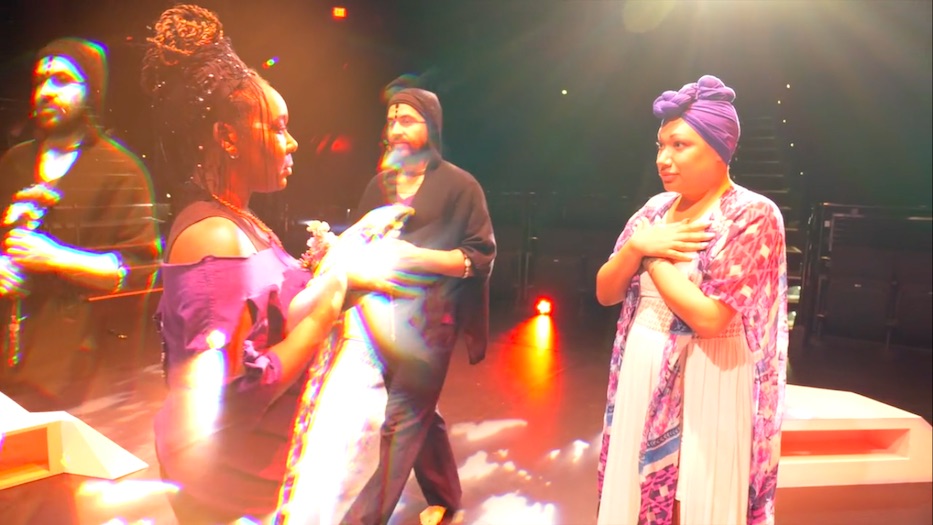
Long Wharf Theatre | Music | Poetry | Arts & Culture | Theater | Arts & Anti-racism
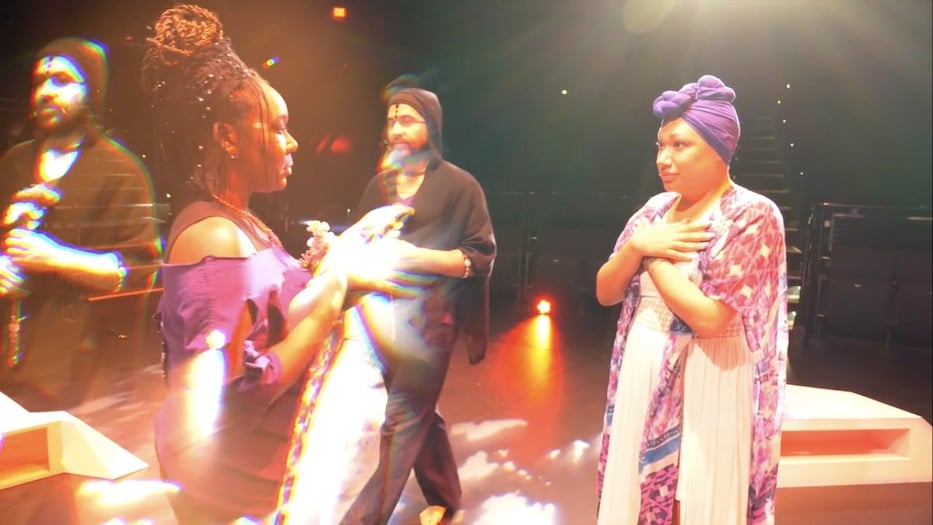
Images from the film. Yerba Bruja runs through June 25. The show’s production team includes Agosto, set designer and spirit guide Mercury, choreographer and spirit guide Jeanika Browne-Springer, videographer Nivia Easterling, photographer Maza Monteiro Rey, and sound designer Mashario Brown.
Jasmin Agosto clears the air around her head, arms windmilling slowly. She lights a bundle of white sage and begins to smudge, walking through the theater. The rows of empty seats stretch out before her. The sage leaves thick, fragrant trails of white smoke hanging in the space.
“Great spirit—great spirits—I call you in the most humbling of reverence,” a voiceover purrs, velvety. “To guide me. My each step. My each breath. My each movement, to clear this space of any ill will. Any harm or unnecessary pain. To cleanse this space, for those of us who come here willing to share our stories.”
It seems fitting that Yerba Bruja, a new production from Long Wharf Theatre and Sageseeker Productions, begins with breath. Directed and produced by Agosto, the 43-minute film and performance features artists Haben Maria, Colleen Ndemeh, Paul Bryant Hudson, Zvlu, Yexandra “Yex” Diaz and Ch’Varda (Jazlyn Council). By the end, it feels as fundamental and as necessary as exhaling and remembering to inhale again.
It runs on Vimeo through midnight on June 25.
In just under 45 minutes, cast members fuse storytelling, music, prayer, ritual, and propulsive movement to make a performance that is also an opening for healing. The show’s production team includes Agosto, set designer and spirit guide Mercury, choreographer and spirit guide Jeanika Browne-Springer, videographer Nivia Easterling, photographer Maza Monteiro Rey, and sound designer Mashario Brown.
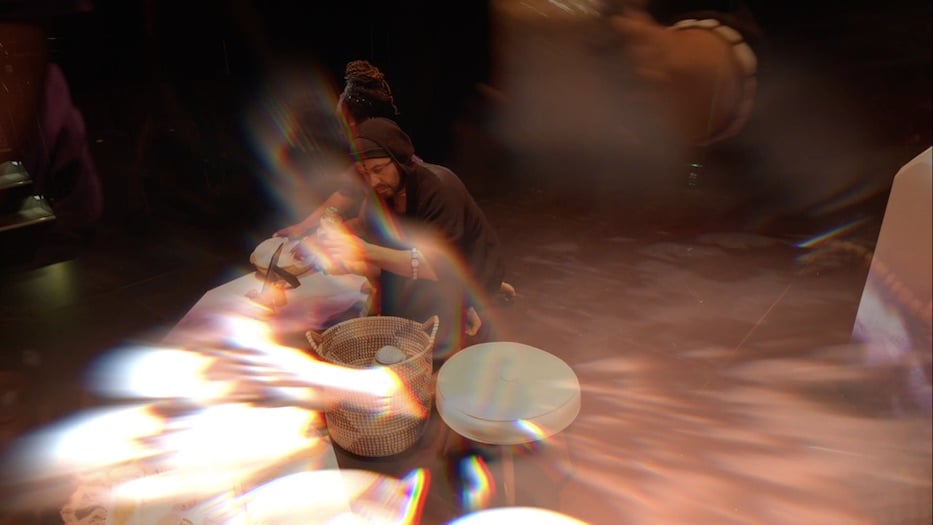
Named for the hearty medicinal plant “that can survive the most hostile of conditions,” Yerba Bruja centers multimedia storytelling from the start. Like its botanical inspiration, the work has embraced a sort of wild and unrestricted growth, thanks largely to a creative team willing to stretch, experiment, and lean into the poetry of its cast. The performance moves back and then surges forward. It catches lovingly on memory and then uses it as a source of propulsion.
When Agosto crumbles flowers and praises the curanderas or healers who have come before, when she conjures the ancestors and the spirit guides, she lets a viewer know that this journey will be a nonlinear one. They’re rewarded if they stick with it. Even her early act of clearing the theater is thick with intention: it tells the story of a toxic, once-poisoned space without ever using the words. It lays the groundwork for a stage on which these stories, and the heart they demand, are possible.
In some ways, Yerba Bruja is a meditation in three separate, interlocking parts. In the first, titled “Remembrance,” Maria and Ndemeh take the stage one at a time, moving through the pasts to get to their shared present. Maria takes the stage first, a long stick of incense in her hand. Ribbons of fragrant smoke follow her hand. St-ooo-ries/ of our mothers/Keep me hooo-l-din on, she sings. Her voice, clear as a bell, fills the space.
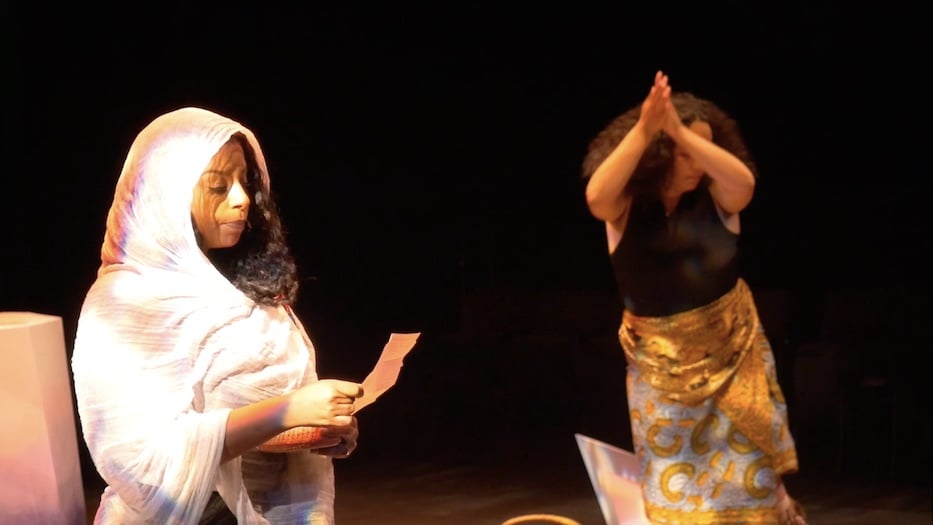
Maria, in the foreground, closes "Remembrance" with a poem as Ndemeh dances.
A viewer can almost imagine sitting in the audience, face to face with these storytellers. When Ndemeh enters, it is with all five senses—she wears foot rattles and begins to move. Ethereal vocals rise in the background. No sooner has she slowed than Maria begins a story of her mother and sister, fleeing Ethiopia for Sudan during the dictatorship of Mengistu Haile Mariam. There's a great tenderness between the two, who sit among the steam of fresh, brewing coffee, then grow their performance to include dance, movement and poetry.
“It’s a very strange, strange story,” Maria begins, the camera tracing the bone-white fabric of her skirt, brightly embroidered details and a fan that cuts the air around it. “Barely any water. No food. Really no rest.”
One day, Maria’s mother discovered that her feet would no longer carry her. She collapsed against a tree. “And she felt her mind leaving her body,” Maria tells Ndemeh, and by extension her listeners. As she speaks, Maria’s hands work from memory doing the buna, a traditional Ethiopian coffee ceremony.
It was at that moment her mother began having visions, and slowly preparing to die in the wilderness. “[She] started to wonder which one was going to get her first," Maria says. "Am I going to die from a snake bite? Is a guerrilla fighter going to get me?”
Then the person who had been leading the group of refugees returned to her. He picked her body off the ground, placed her on his back, and ran back to the group.
“He risked everything for one person,” she says. “So much resilience.”
“Resistance,” Ndemeh replies, pushing back. Or maybe it’s adding a voice. It’s a linguistic shift that she knows well: she weaves a thread from the East Coast back to her maternal home of Liberia, and then back to the East Coast. In her words, she holds not just her mother but millions of immigrants who have unique but overlapping narratives of struggle.
“The U.S. was always so much work for all of them,” she says.
In Liberia—an imperfect place that she does not romanticize, Ndemeh adds—“there was more balance.” When her mother and aunt came to the U.S., those immigrant relatives “worked and worked and worked,” pinched by a country born on stolen land and forced labor. The words echo in an America that still puts its immigrants in menial, unsafe and laborious working conditions, commits wage theft and sometimes tells asylum seekers not to come to the U.S. at all.
“I dream of a future where that cycle doesn’t continue,” Ndemeh says. “Where we have joy and rest and pleasure for you and me, for our moms, for our ancestors, for our future descendants. Cause we all deserve that.”
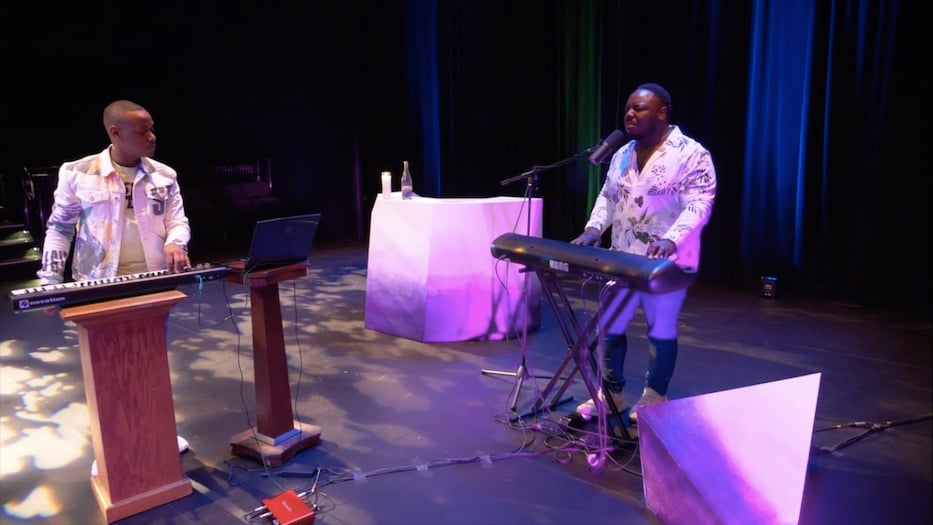
The stories are full in this way: they undo the forward-marching, largely whitewashed fairytale of the American dream to expose the richer, rounder multiplicity of a diaspora. The magic—and it does feel like magic—is in the way they wave in and out of each other, single threads in a large, vibrant tapestry.
That sense of home carries through to “Return,” as New Haven-based musician Paul Bryant Hudson and Hartford-based musician Zvlu launch into a performance, the beat steady. Hudson’s voice—Where do I go/when it’s 25 outside too cold to cry?—undulates as it takes a listener back to his safe places. Both artists sink into the music, eyes closed.
When the piece ends, it’s a seamless prelude into a warm, familiar discussion between the two. Hudson sifts through old photographs, stored in a notebook he gifted to himself. He lifts the images to the light, and they are sweet time capsules: Hudson’s early homes in the Hill and Newhallville neighborhoods of New Haven. Hudson and his dad snuggling on the couch that stayed in the family for years. A tiny Hudson and his mom at the hospital following his birth, “which is home, right, if ever there was one.”
He points out the Division Street home of his great-grandmother Syla A. Artis Branch, the nucleus of the family for years. He looks back at the family’s Elizabeth Street duplex, which felt like “a castle” to him. There’s something deeply relatable but also completely his here, enveloped in the softness with which he speaks.
Now a father himself, Hudson holds each photograph delicately, literally carrying his past with him. When the two artists walk off stage, there’s the sense that there are so many more anecdotes waiting in the wings.
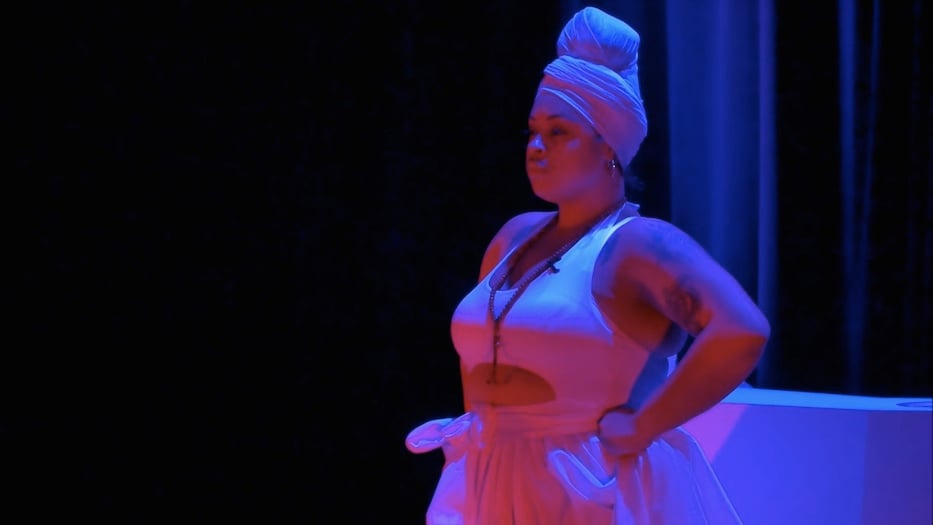
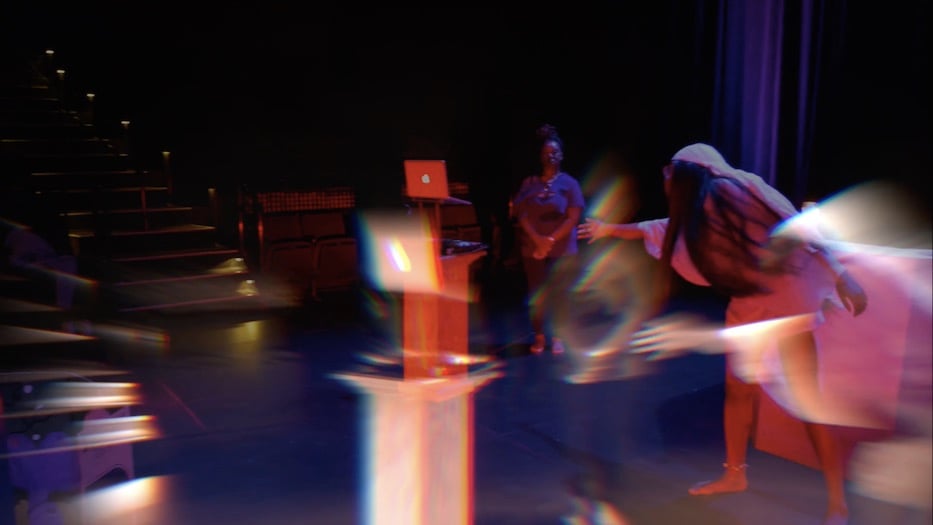
In a final movement titled “Respect,” artists Diaz and Ch’Varda bring the performance full circle. Standing in all white at center stage, Diaz holds the space as her arms weave upwards, wrists flexing. She and Ch’Varda bow to each other, a sign of mutual respect that doubles as a kind of beginning and an end.
Diaz beats her arms and ushers in a drum-like heartbeat, paying homage to the tradition of resistance through Bomba. As singers pumped through a computer conjure La Negra Martina, her body channels the story of a woman who danced people out of slavery in Puerto Rico. The camera slows and speeds up, fusing past and present.
Diaz moves right into a poem. The words, muscled as they enter the theater, mourn the sheer toll of white supremacy, from lives lost to the erasure of whole belief systems. As she reads—You grew from concrete/And when you blossomed the ground cracked—the lighting and visual work from Easterling, Rey and Brown is a character unto itself, leaving Diaz and Ch’Varda double exposed and surrounded by sheaves of bright light. Ch’Varda moves, and every spirit in the space moves with her. She gives herself over to the music.
Together, these moving parts weave a narrative of great reverence, remembrance, resilience and resistance in a city—and on a stage—where those stories have been overlooked, suppressed, and ignored for so long. For its leap from stage to screen, the production is also rendered with great intimacy. It envisions a bright future for not just the artists but for Long Wharf, where these artists are welcome. It is, perhaps, also a prayer: that these narratives will be the norm, and not the exception, as the theater begins to reopen its doors.
Yerba Bruja is a collaboration between Long Wharf Theatre and Sageseeker Productions. Watch it through June 25 here. Watch a virtual conversation among the artists from Hartford Stage here.

